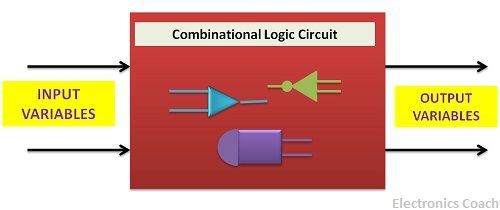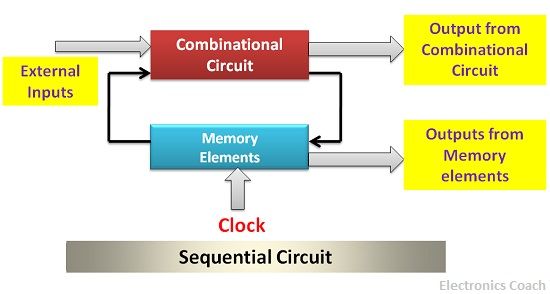The major difference between combinational and sequential logic circuit is that the combinational logic circuit consists of only logic gates while the sequential logic circuits consist of logic gates and memory elements.
Another crucial factor which differentiates combinational and sequential logic circuit is the state of output elements. The state of the output elements of the combinational circuit depends on only present state of the input elements. On the contrary, the output obtained from sequential circuit depends on the present state of the input as well as past state of the output.
We will discuss other crucial difference between combinational and sequential logic circuit with the help of comparison chart, but before that let’s have a look at the topics covered in this article.
Content: Combinational and Sequential Logic Circuit
| Parameters | Combinational Logic Ciruit | Sequential Logic Circuit |
|---|---|---|
| Definition | It is a logic circuit which generates output based upon present inputs. | It is logic circuit which generates output based on present input as well as past output. |
| Memory Element | Memory element is not present in combinational logic circuit. | Memory element is present in sequential logic circuit. |
| Feedback loop | Feedback loop is not present. | Feedback loop is present. |
| Output obtained | Combination of operands not necessary in same sequence. | Sequence of operands is necessary in sequential circuit. |
| Examples | Half Adder, Full Adder, Encoder, decoder, multiplexer, demultiplexer etc. | Finite state machine |
Definition
Combinational Logic Circuit
The combinational logic circuit comprises of logic gates and thus the output obtained is directly related to the input. There are no feedback elements in case of the Combinational logic circuit. The word combinational is derived from the word combination which means two or more elements combined together by means of single operation.

A combinational logic circuit has NAND, NOR, and NOT logic gates. These are the building blocks of the digital circuitry. A combinational circuit provides the variety of operations such as the arithmetic operation of two operands, transmission of data, conversion of code etc.
With the help of logic gates, the combinational circuit performs an operation like addition, subtraction or code conversion from binary to BCD, BCD to binary etc. The output of the combinational logic circuit can be described in various ways such as Boolean algebra, truth table, and logic gates.
The combinational circuit can take any number of input and the output generated from the circuitry is dependent on the state of the input. Any change in the input will also be reflected in the output terminals.
Various types of combinational circuit exist among which multiplexer and demultiplexer are the significant ones which are used in various applications. Other combinational circuits are the encoder, decoder, half adder, full adder, Binary to BCD converter etc.
Sequential Logic Circuit
The sequential logic circuit also involves memory elements along with the logic gates. Thus, the output generated by the sequential circuit depends not only on the present state of the input but also on the previous outputs.

The sequential circuit involves usage of feedback loops, with the help of this the state of the previous output is recorded. Thus, the next output is controlled by the state of the previous output. The memory present in the sequential circuit keeps the track of the output and the thus, the output is produced.
The word sequential is derived from the word sequence which means in a definite order. To understand the operation of the sequential circuit let’s take an example of television circuitry. The television is also a type of sequential circuit. The keys available in remote to change the channel or up and down keys to adjust the volume, this entire process is sequential.
When you select a particular channel the Television receiver keeps the track of the previously selected channel and according to that, the next channel is selected.
Sequential circuits are the fundamental unit of digital circuits. The most popular example of the sequential circuit is the finite state machine. There are basically, two types of Sequential Circuit, one is synchronous and the other is Asynchronous Sequential circuit.
Synchronous Sequential Logic Circuit is the one in which the output is generated with the input and the clock signal. A clock signal is given in the definite time interval. On the contrary, the asynchronous sequential logic circuit generates the response at any time whenever there is a change in the input terminals.
Key Differences between Combinational and Sequential Logic Circuit
- The Combinational and sequential logic circuit, both are the building block of the digital circuits but the presence of memory elements creates the major difference. The combinational logic circuit does not possess any memory element while the sequential logic circuit comprises of the memory elements.
- The output obtained from combinational and sequential logic circuit also varies from each other. The output generated from the combinational circuit is the function of the present inputs only. But the output obtained from the sequential circuit is dependant on the present input as well as the past output.
- The feedback loop is not present in case of combinational logic circuits. But the sequential logic circuit must comprise of it in order to track the past output.
- The Clock signal is not used in the combinational circuit but sequential uses clock to provide synchronization.
- The designing process of the combinational circuit is much simple as compared to that of the sequential circuit.
Conclusion
The combinational and sequential logic circuit is designed to meet different applications. But practically, most circuits use the combination of combinational as well as the sequential circuit to meet their needs. The combinational circuit will provide the output based on the function of the input. On the contrary, the sequential circuit will generate the output based on the state of the memory element. It keeps the track of the past input and the previous outputs.
Leave a Reply